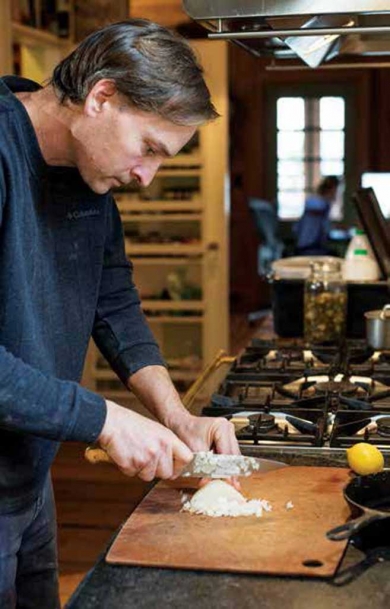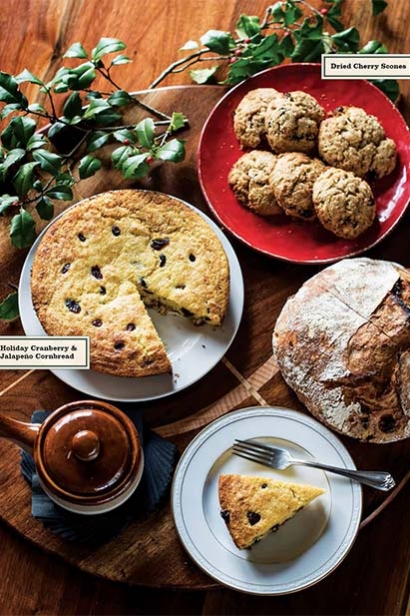Against The Grain
Doing things his own way produces superb bread
Tom Edwards wasn’t looking for inspiration when he set out to bake an ordinary loaf of kamut bread a few years ago, he was just in the mood to work some dough. Yet instead of reaching for a sack of store-bought flour, Edwards milled the grain on the spot and went to work.
“I did like I always do: made the loaf, let it rest and cracked into it,” says Edwards, a business consultant and founder of The Artisan Bread School in Anchorage. “It was like, ‘Wow! This is different!’ It was like I’d been baking bread that was black and white all this time, and now I’d added a color palette to it.”
To be precise, grinding whole grain and using it immediately added the “color.” Once grain is ground and exposed to air, volatile oils are released along with complex flavors. It also reduces enzymatic activity, which is crucial for fermentation.
Edwards kept milling his own grain each time and got hooked on the results. Flavors were brighter and richer and his loaves rose like never before.
“Just milling that grain … smelled like someone was cutting grass nearby; the smell was so foreign to me,” he says. “[Packaged] white flour doesn’t have any smell. But I can stick my nose into a bowl and smell the life in milled grain.”

Fast-forward to 2013, when Edwards recognized a three-pronged business opportunity: He’d buy a stone mill to grind organic grains for local customers, he’d also use the grain to bake bread for sale and he’d create a demand that would lead local farmers to produce organic grains. But though he found a stone mill that could grind as much as 200 pounds of grain per hour, he had no idea where to get organic grains to run through it.
“My sister, Lori [Himmelsbach], and I were driving to Ohio to get the mill before it dawned on me that I had no grain source,” Edwards recalled. As he drove, Himmelsbach made several calls and learned Berea College has one of largest organic farms in the country. Turned out the school’s students grew organic Red Turkey Heritage wheat, which gave Edwards his source.
Yet while that solved his short-term needs, his long-term ambition included getting professional farmers to produce the organic wheat. If he could create demand through his business, he could convince farmers to produce the wheat.
“That makes us the conduit between the consumer and farmer, and we’re giving access to organic grains and products,” Edwards says. “We’re almost at that point. It’s where we want to be.”
GRIST FOR THE MILL
As Edwards explains his vision for the company he’s named Louismill, he mixes a batch of cornbread from just-milled dent corn flour. As the bread bakes, he stirs two different pots of grits cooking on the stove: one filled with Louismill’s standard corn grits, the other with its smoked grits. (Louismill grits and ground wheat flour are sold online at Squareup.com/market/mozzapi-store.)
Tim Smith, executive chef at Crescent Hill Craft House, uses Louismill’s freshground wheat flour for their brunch waffles and their dinnertime chicken–and-waffle entrée.
“The side of our building says, ‘Local Food. Local Beer,’ so we try to live up to that as much as possible,” Smith says. “His is an outstanding product, just beautiful stuff.”
At his upcoming Royals Hot Chicken restaurant in NuLu, owner-chef Ryan Rogers will use Louismill grits.
“We going to use them in our pimento cheese grits,” says Rogers. “Tom’s were maybe the best grits I’ve had in my life.”
Through his Artisan Bread Camps, held about once a quarter, he also wants to increase the number of professional bread bakers and bakeries in Louisville. That would strengthen demand for his flour and create better bread for the marketplace. “Blue Dog Bakery is the only true artisan bakery here, and they do a great job,” Edwards says. “But that we have just one of those in a city this size is truly remarkable. You should see what’s happening in Asheville [NC]. I want to help create a similar artisan bread culture here.”
Which will take work given bread’s lingering negative stigma in the wake of the low-carb craze, not to mention the increase in (real or perceived) gluten allergies.
“Where I’ve turned is to not look at gluten, but to look at the nutritional value of that grain and respect it like it has been used all the way back to biblical times,” he says.
Edwards says bread was highly nutritional until the introduction of the hammer mill to industrial grain milling in the 1920s. The new technology’s removal of germ from grain was a boon to shelf life extension, but it also took away vital nutrients and flavors found in whole grain. Edwards learned all this after diving into a serious study of corn subtly forced on him by a chef customer who wants to create a sugar-free cornbread rather than a white bread for his restaurant.
“I asked him how he was going to do that since every time I had cornbread without sugar, it was just a good excuse to use honey and butter,” Edwards says. “I got back to researching how to make cornbread the way they made it a long time ago, and I stone milled it and made a batch. And it was the first cornbread I’d ever had that didn’t need put honey or butter on it.”
This year Edwards and Himmelsbach also launched a community-supported bakery program that produces weekly “bread shares” for about 25 customers. As in CSAs, CSB customers pay a set amount ($125) up front for an 18-week share, and they receive two loaves of whatever Edwards bakes. Bread is picked up each Friday at two Louisville locations.
Chris Boone is a bread share customer who couldn’t pass up the chance to indulge in such a wide variety of artisan breads, loaves he and his wife share with friends at church.
“What Tom is doing with that bread is really remarkable,” Boone says. Customers also receive weekly emails suggesting optimal uses for each new loaf. “We’ve tried each of his suggestions and he hits it right on the mark each time. I’d like to say which particular loaf was my favorite, but every bread has been a favorite in some way or form.”
Bev Anderson, a bread camp veteran, said she and her classmates—a mix of home cooks and professional chefs—each baked 40 loaves over the course’s fiveday run. A vegan, Anderson says meal preparation is sometimes a challenge, but learning so many bread styles at camp broadened her repertoire.
“Plus, at camp, they cook these lovely lunches and dinners with accompaniments to what we’d made that day,” Anderson says. “It’s incredible to learn how to make bread like they made hundreds of years ago. It really opened my eyes.”
And as if launching a grain milling and bread share operation weren’t enough, Edwards and Himmelsbach plan to open MozzaPi next year in Anchorage. The full-service pizzeria is named after their mobile wood-fired pizza baking and catering operation, which Edwards founded several years ago to give Louisville its first taste of Neapolitan-style pizzas.
“Pizza is just a blast to make because it happens so fast,” says Edwards. His personal- size pizzas bake in about 90 seconds in the oven’s 900° heat.
MozzaPi’s building has yet to be built, and that likely means the pizzeria’s debut will be in the late spring of 2016. Asked whether the October opening of Coals Artisan Pizza just a few blocks away was good or bad, the ever-positive Edwards just grinned.
“It’s great because it draws more attention to artisan pizza making. That’s the kind of change I want to see with everything we’re doing in Louisville.” Steve Coomes is a former chef and freelance writer in Louisville.
All Louismill flours, mixes, and grits are available for purchase online at Louismill.com. They are also available for pickup with the Community Supported Bread Program on Fridays. For information about the Artisan Bread School: ArtisanBreadSchool.com.







